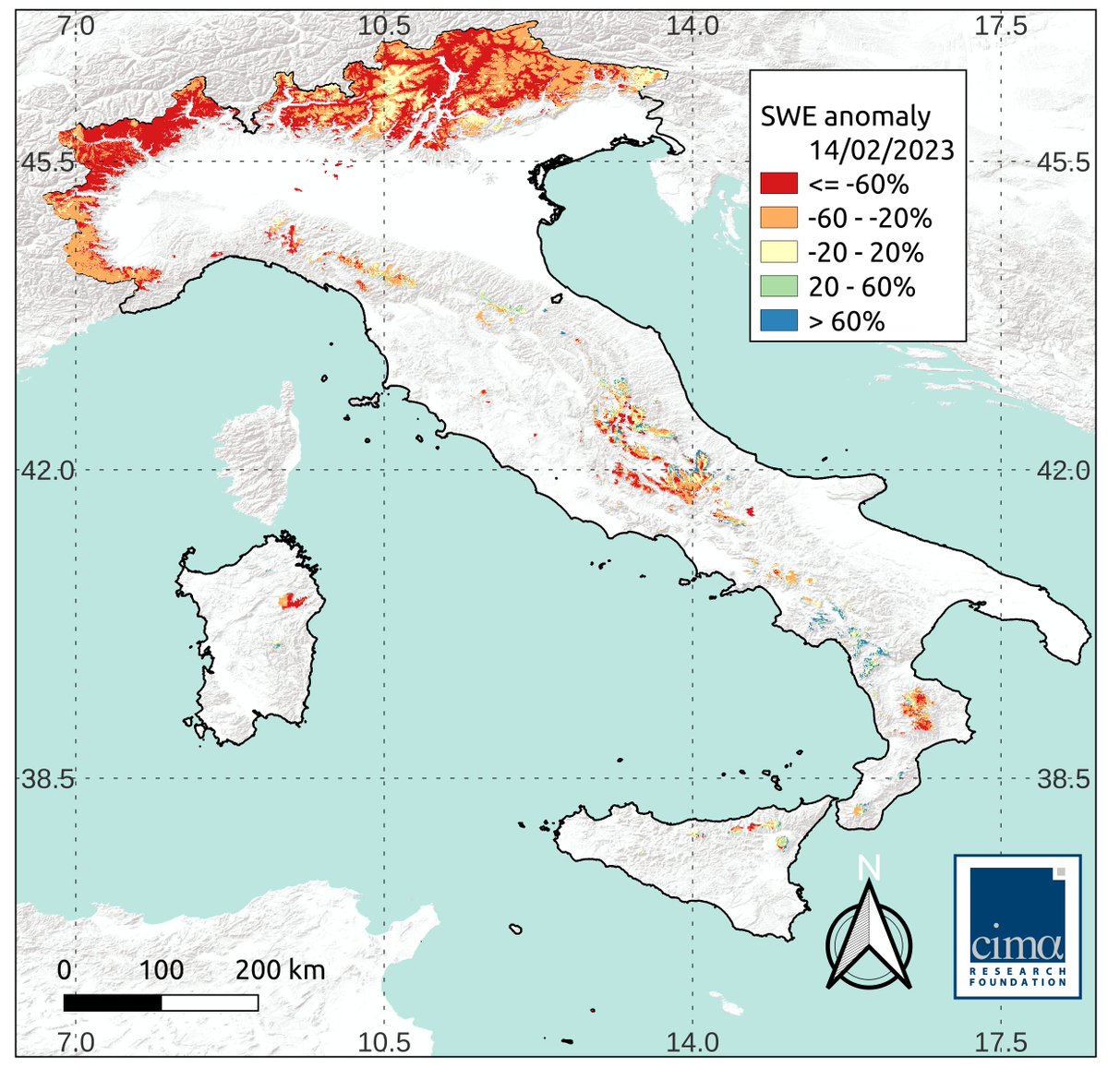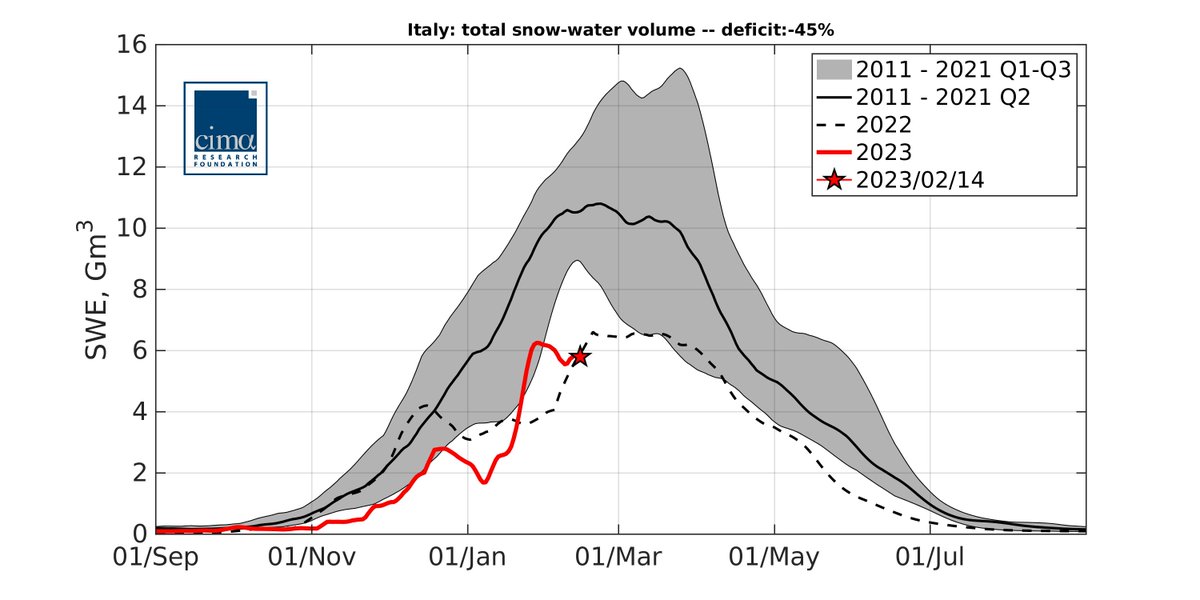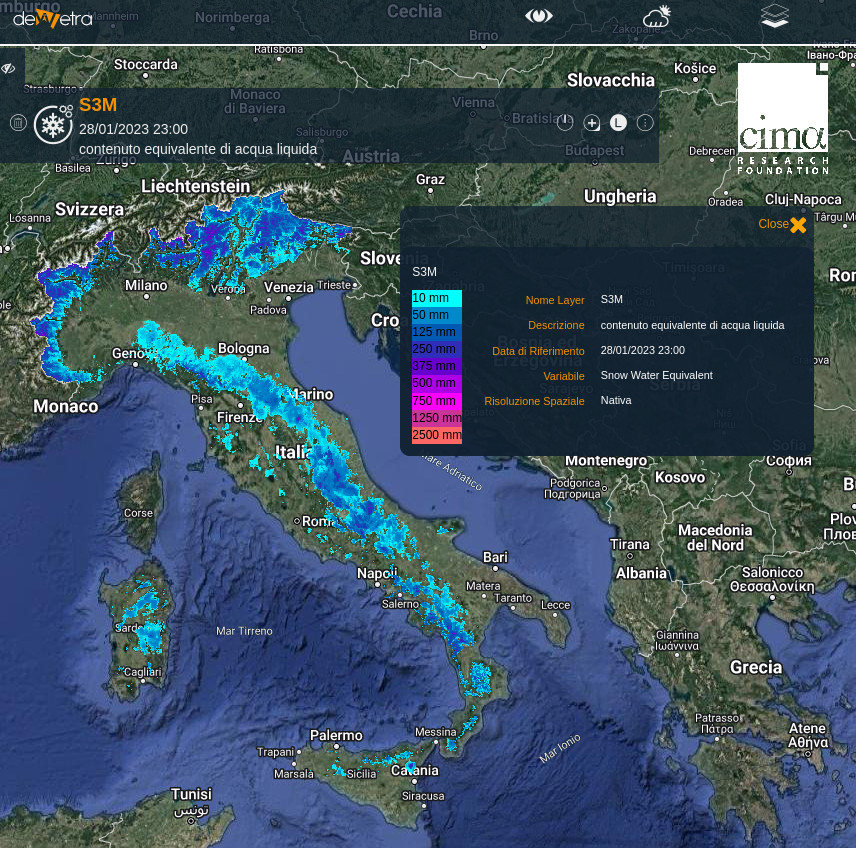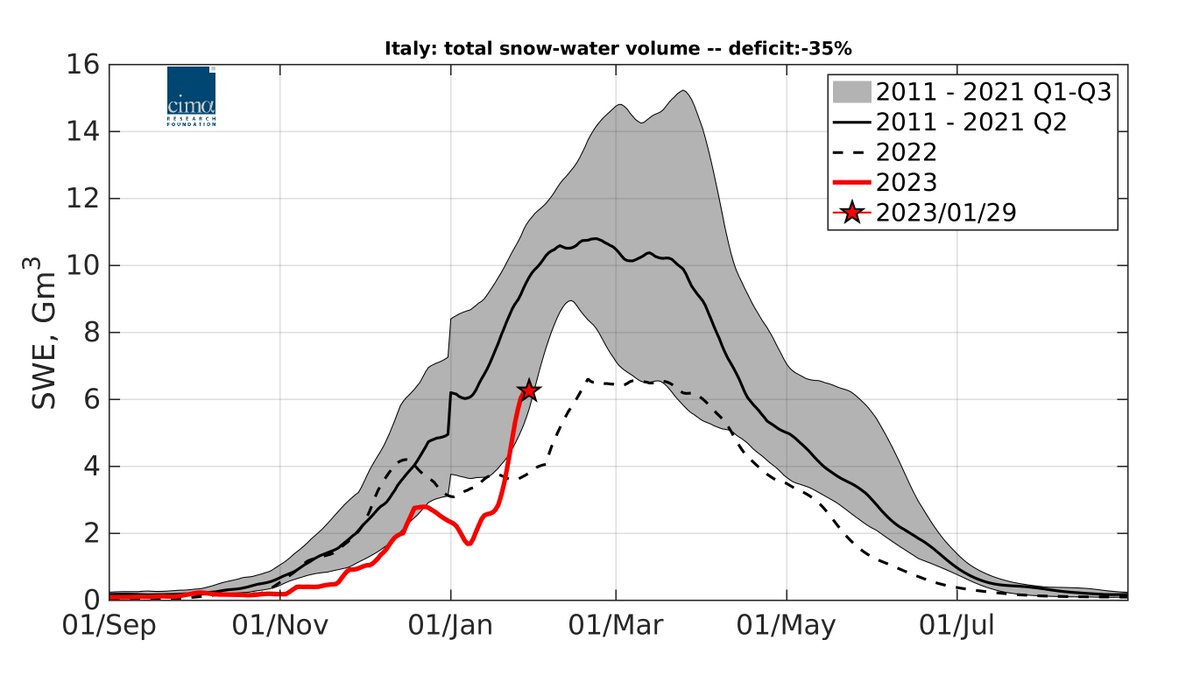
Siamo a metà febbraio e sono passate altre due settimane di maratona per la stagione 2023 della #neve in Italia. ❄️
Aria fredda ma condizioni complessivamente asciutte, soprattutto sulle Alpi... Come sta andando il #deficit italiano di risorse idriche nivali?
Leggi il thread👇🧵
Aria fredda ma condizioni complessivamente asciutte, soprattutto sulle Alpi... Come sta andando il #deficit italiano di risorse idriche nivali?
Leggi il thread👇🧵

Non abbiamo visto molte nuove nevicate dopo la fine di gen. Al momento, quindi, stimiamo che le risorse idriche nivali su scala nazionale siano la metà rispetto al 2011-21 (deficit -45%).
A livello nazionale, le condizioni rimangono simili al 2022, un anno di #siccità rilevante👇
A livello nazionale, le condizioni rimangono simili al 2022, un anno di #siccità rilevante👇

Un riepilogo su questo grafico 👆
L'asse X è il tempo, dall'autunno all'estate.
L'asse Y è lo Snow Water Equivalent, cioè quanta acqua abbiamo nella neve (più è alta, meglio è).
Linea nera: mediana per il periodo 2011-2021.
Linea rossa: 2023.
Linea tratteggiata: 2022.
L'asse X è il tempo, dall'autunno all'estate.
L'asse Y è lo Snow Water Equivalent, cioè quanta acqua abbiamo nella neve (più è alta, meglio è).
Linea nera: mediana per il periodo 2011-2021.
Linea rossa: 2023.
Linea tratteggiata: 2022.
Che dire di Q1 e Q3? Sono il 1° e il 3° quartile dello SWE storico. Se l'at-tuale SWE è sotto Q1 (come ora), siamo nel 25% degli anni con SWE più basso nei nostri 12 anni di storia.
Le condizioni “medie” sono comprese tra Q1-Q3; sopra a Q3 le stagioni con abbondanza di neve.
Le condizioni “medie” sono comprese tra Q1-Q3; sopra a Q3 le stagioni con abbondanza di neve.
Perché siamo ancora in deficit nonostante il recente "freddo"? La #temperatura è un ingrediente della stagione nevosa, l'altro sono le #precipitazioni. Poche quest’anno, soprattutto sulle Alpi... Dopo un inizio tardivo e un fine anno caldo, questo è il 3° ritardo nella maratona. 

Nel bacino del #Po, ad esempio, abbiamo 1/3 di neve rispetto all'ultimo decennio. Oggi stimiamo circa le stesse risorse idriche nivali dell'anno scorso e ci avviciniamo al periodo di massimo accumulo.
Il tempo per accumulare la neve sta finendo, inizierà a fondere in primavera.
Il tempo per accumulare la neve sta finendo, inizierà a fondere in primavera.

La situazione è solo di poco migliore nel NE IT, dove stimiamo la metà delle risorse idriche nivali rispetto all'ultimo decennio nel fiume #Adige.
Qui, il deficit di neve è maggiore rispetto all'anno scorso, con oltre mezzo miliardo di m cubi d'acqua in meno rispetto al 2022.
Qui, il deficit di neve è maggiore rispetto all'anno scorso, con oltre mezzo miliardo di m cubi d'acqua in meno rispetto al 2022.

I fiumi Po e Adige ospitano circa il 75% delle risorse idriche nivali nazionali al picco di accumulo. Nel Po, il volume di picco della neve può essere anche pari o superiore al 60% della portata annuale👇
Questo deficit di neve è l'acqua che avremo (o non avremo) in estate.
Questo deficit di neve è l'acqua che avremo (o non avremo) in estate.

In IT centro-sud, la neve fonde rapidamente e raramente si protrae all'estate. Sul fiume #Tevere, ad es, siamo passati da un'anomalia positiva a un deficit del -34% in 10 gg.
La neve in aree con temperature e precipitazioni stagionali elevate è chiamata "marittima". Curioso, no?
La neve in aree con temperature e precipitazioni stagionali elevate è chiamata "marittima". Curioso, no?

Ecco l'attuale mappa del deficit nazionale di risorse idriche nivali. Il rosso indica aree con quantità di neve inferiore al 2011-21. Le nevicate di fine gen hanno migliorato un po' la situazione nelle Alpi sud-ovest, ma il deficit rimane elevato nelle Alpi nord-ovest e centrali. 

Due variabili da tener presenti se si parla di neve e risorse idriche: l'estensione (dove) e la profondità della neve (quanta). Alimentando i nostri modelli fisici con immagini satellitari e rilievi a terra, IT-SNOW fornisce le informazioni in tempo reale: bit.ly/3E8b2gI 

Dal punto di vista storico, rimane circa un mese per l'accumulo di neve, dato che il picco di accumulo in Italia si verifica il 4 marzo ± 10 giorni.
🔜 Pubblicheremo un'altra valutazione dopo il giorno del picco di accumulo.
See you on the other side!
👉 cimafoundation.org/news/neve-gli-…
🔜 Pubblicheremo un'altra valutazione dopo il giorno del picco di accumulo.
See you on the other side!
👉 cimafoundation.org/news/neve-gli-…

• • •
Missing some Tweet in this thread? You can try to
force a refresh
















